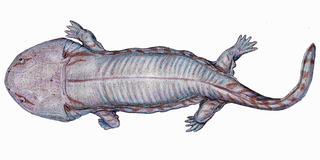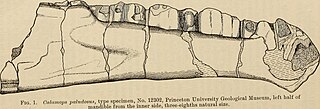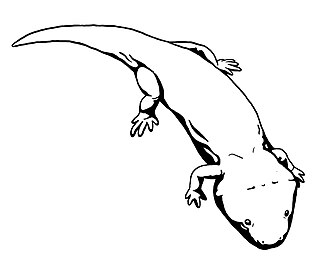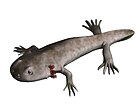
Temnospondyli is a diverse order of small to giant tetrapods—often considered primitive amphibians—that flourished worldwide during the Carboniferous, Permian, and Triassic periods. A few species continued into the Jurassic and Cretaceous periods. Fossils have been found on every continent. During about 210 million years of evolutionary history, they adapted to a wide range of habitats, including fresh water, terrestrial, and even coastal marine environments. Their life history is well understood, with fossils known from the larval stage, metamorphosis, and maturity. Most temnospondyls were semiaquatic, although some were almost fully terrestrial, returning to the water only to breed. These temnospondyls were some of the first vertebrates fully adapted to life on land. Although temnospondyls are considered amphibians, many had characteristics, such as scales, claws, and armour-like bony plates, that distinguish them from modern amphibians.

Mastodonsaurus is an extinct genus of temnospondyl amphibian from the Middle Triassic. It belongs to a Triassic group of temnospondyls called Capitosauria, characterized by their large body size and presumably aquatic lifestyles.

Metoposaurus meaning "front lizard" is an extinct genus of stereospondyl temnospondyl amphibian, known from the Late Triassic of Germany, Italy, Poland, and Portugal. This mostly aquatic animal possessed small, weak limbs, sharp teeth, and a large, flat head. This highly flattened creature mainly fed on fish, which it captured with its wide jaws lined with needle-like teeth. Metoposaurus was up to 3 m long and weighed about 450 kg. Many Metoposaurus mass graves have been found, probably from creatures that grouped together in drying pools during drought.

The Stereospondyli are a group of extinct temnospondyl amphibians that existed primarily during the Mesozoic period. They are known from all seven continents and were common components of many Triassic ecosystems, likely filling a similar ecological niche to modern crocodilians prior to the diversification of pseudosuchian archosaurs.

Intasuchus is an extinct genus of temnospondyl amphibian from the Middle Permian of Russia. It is known from a single species, Intasuchus silvicola, which was named in 1956. Intasuchus belongs to the family Intasuchidae and is probably its sole member, although other taxa such as Syndyodosuchus and Cheliderpeton have been assigned to the family in the past. Intasuchus most likely belongs to the group Archegosauroidea, Permian relatives of the large, mostly Mesozoic temnospondyl clade Stereospondyli.

Konzhukovia is an amphibian genus that belongs to an extinct group of temnospondyls, the largest clade of basal tetrapods including about 198 genera, 292 species, and more than half of which were alive during the early Mesozoic period. The animal was a predator that lived about 260 million years ago, and could get up to about 3 meters in length. Specifically, Konzukovia lived during the Permian, between 252 and 270 million years ago according to the type of rock the fossil was found in. There are three species within this genus, K. vetusta, K. tarda, and K. sangabrielensis, the first two originating from Russia while the latest originating from Southern Brazil. The discovery of this specimen in Southern Brazil provided more evidence to support the idea that during this animals existence, there was a “biological corridor” because of the supercontinent Pangea, allowing these species to be found so far apart from each other. Konzhukovia belongs to the family Archegosauridae, a family consisted of large temnospondyls that most likely compare to modern day crocodiles. Since the discovery of the latest species, K. sangabrielensis Pacheco proposes that there must be the creation of a new family, Konzhokoviidae, a monophyletic group in a sister-group relationship with Stereospondlyi in order to accommodate the three species. Konzhukovia skulls usually exhibit typical rhinesuchid features including an overall parabolic shape, small orbits located more posteriorly, and the pterygoids do not reach the vomer. These animals were long-snouted amphibians that had clear adaptations made for fish catching, as well as exemplifying aquatic features.

Lydekkerinidae is a family of stereospondyl temnospondyls that lived in the Triassic period. During the Triassic, lydekkerinids had a global distribution. They were small-bodied with wedge-shaped, roughly triangular heads. Fossils have been found in Russia, Greenland, India, South Africa, Madagascar, and Australia. The type genus is Lydekkerina, the namesake of the family and the best-known lydekkerinid.

Stereospondylomorpha is a clade of temnospondyls. It includes the superfamily Archegosauroidea and the more diverse group Stereospondyli. Stereospondylomorpha was first proposed by Yates and Warren (2000), who found Archegosauroidea and Stereospondyli to be sister taxa in their phylogenetic analysis. A similar clade is Archegosauriformes, named by Schoch and Milner (2000), which includes Stereospondyli and some Permian temnospondyls that are similar in appearance to stereospondyls, including the archegosauroids. However, according to Schoch and Milner's phylogeny, Archegosauroidea is a paraphyletic group of taxa that are successively basal to Stereospondyli, rather than a monophyletic sister taxon.

Limnarchia is a clade of temnospondyls. It includes the mostly Carboniferous-Permian age Dvinosauria and the mostly Permian-Triassic age Stereospondylomorpha. The clade was named in a 2000 phylogenetic analysis of stereospondyls and their relatives. Limnarchia means "lake rulers" in Greek, in reference to their aquatic lifestyles and long existence over a span of approximately 200 million years from the Late Carboniferous to the Early Cretaceous. In phylogenetic terms, Limnarchia is a stem-based taxon including all temnospondyls more closely related to Parotosuchus than to Eryops. It is the sister group of the clade Euskelia, which is all temnospondyls more closely related to Eryops than to Parotosuchus. Limnarchians represent an evolutionary radiation of temnospondyls into aquatic environments, while euskelians represent a radiation into terrestrial environments. While many euskelians were adapted to life on land with strong limbs and bony scutes, most limnarchians were better adapted for the water with poorly developed limbs and lateral line sensory systems in their skulls.
Almasaurus is an extinct genus of trematosaurian temnospondyl within the family Latiscopidae. It is known from several skulls and some postcranial material found from the Argana Formation in Morocco, which dates back to the Late Triassic.

Calamops is an extinct genus of large temnospondyl amphibian known from the base of the Solebury Member of the Late Triassic Newark Supergroup of Pennsylvania, United States. Calamops was first named by Sinclair in 1917 and the type species is Calamops paludosus. It was usually thought to be a metoposaurid of questionable validity as its holotype and only known specimen, which comprises three pieces of a left mandibular ramus, had never been prepared. Following a preparation and casting of the specimen, Hans-Dieter Sues and Rainer R. Schoch found in 2013 Calamops to represent a valid taxon of trematosauroid temnospondyls that can be diagnosed by several autapomorphies. It represents one of the geologically youngest known long-snouted trematosaurs and the first record of these temnospondyls from the Late Triassic of North America. It is also the oldest known tetrapod fossil from the Triassic of the Newark basin.

Dissorophus (DI-soh-ROH-fus) is an extinct genus of temnospondyl amphibian that lived during the Early Permian Period about 273 million years ago. Its fossils have been found in Texas and in Oklahoma in North America. Its heavy armor and robust build indicate Dissorophus was active on land, similar to other members of the clade Dissorophidae that are known from the Late Carboniferous to the Early Permian periods. Dissorphus is distinguished by its small body size, disproportionately large head and short trunk.

Indobrachyops is an extinct genus of temnospondyl amphibian from the Early Triassic of India. It is known from a nearly complete fossil skull that was first described by paleontologists Friedrich von Huene and M. R. Sahni in 1958 from the Panchet Formation in Raniganj Coalfield. Indobrachyops belongs to a group of mostly semi-aquatic temnospondyls called Stereospondyli, but its exact placement within the group has been uncertain since its first description.

Lapillopsis is an extinct genus of stereospondyl temnospondyl within the family Lapillopsidae. Fossils belonging to the genus have been found in the Arcadia Formation of Queensland, Australia.
Tersomius is an extinct genus of dissorophoid temnospondyl within the family Micropholidae. It is known from the early Permian of North America.

Anaschisma is an extinct genus of large temnospondyl amphibians. These animals were part of the family called Metoposauridae, which filled the crocodile-like predatory niches in the late Triassic. It may have reached up to 3 metres (9.8 ft) in length, with a 65 centimetres (26 in) long skull. It was an ambush hunter, snapping up anything small enough to fit in its huge jaws. It was very common during the Late Triassic in what is now the American Southwest.

Vigilius is an extinct genus of brachyopid temnospondyl amphibian from the Triassic of Arizona. It is known from the single type species Vigilius wellesi.
Chinlestegophis is a diminutive Late Triassic stereospondyl that has been interpreted as a putative stem caecilian, a living group of legless burrowing amphibians. If Chinlestegophis is indeed both an advanced stereospondyl and a relative of caecilians, this means that stereospondyls survived to the present day; historically the group was thought to have gone extinct by the early Cretaceous. Chinlestegophis jenkinsi, the type and only species, is known from two partial skulls discovered in the Chinle Formation in Colorado.
Latiscopus disjunctus is a small Late Triassic temnospondyl collected in 1940 by a Works Projects Administration crew working near Otis Chalk, Texas that was described by John Wilson in 1948.
This list of fossil amphibians described in 2018 is a list of new taxa of fossil amphibians that were described during the year 2018, as well as other significant discoveries and events related to amphibian paleontology that occurred in 2018.





























